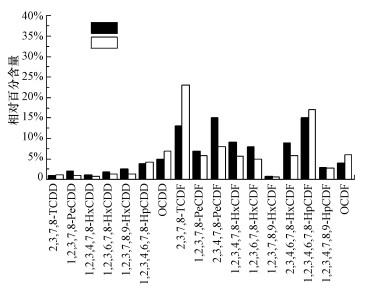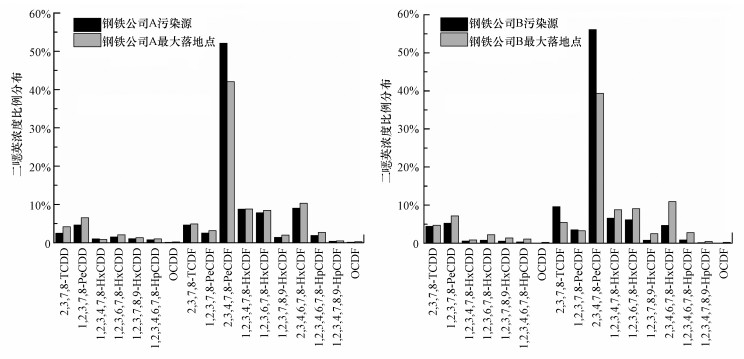 , 付建英2, 林晓青3, 陈彤3, 詹明秀4
, 付建英2, 林晓青3, 陈彤3, 詹明秀4

1. 天津市环境监测中心, 天津 300000;
2. 中国联合工程公司, 杭州 310052;
3. 浙江大学热能工程研究所, 能源清洁利用国家重点实验室, 杭州 310027;
4. 中国计量大学计量测试工程学院, 杭州 310018
收稿日期: 2017-09-05; 修回日期: 2017-11-04; 录用日期: 2017-11-20
基金项目: 国家自然科学基金(No.51476138)
作者简介: 王凤炜(1974-), 男, 副高级工程师, E-mail:wangfengwei@126.com
通讯作者(责任作者): 詹明秀, E-mail:zhanmingixu@zju.edu.cn
摘要: 对我国某市6家钢铁企业烟气中的二
 英(PCDD/Fs)污染水平和排放特性做了初步研究,同时对厂区内大气中的二
英(PCDD/Fs)污染水平和排放特性做了初步研究,同时对厂区内大气中的二 英浓度水平进行了分析.结果表明,6家钢铁企业中,铁矿石烧结炉排放的二
英浓度水平进行了分析.结果表明,6家钢铁企业中,铁矿石烧结炉排放的二 英浓度远高于炼钢精炼炉,烧结炉二
英浓度远高于炼钢精炼炉,烧结炉二 英排放浓度为0.098~3.6 ng·Nm-3(以Ⅰ-TEQ计),2个炼钢精炼炉烟气中二
英排放浓度为0.098~3.6 ng·Nm-3(以Ⅰ-TEQ计),2个炼钢精炼炉烟气中二 英的浓度分别为0.0037和0.078 ng·Nm-3(以Ⅰ-TEQ计),烟气排放达标率为66.67%.6家钢铁企业厂区内大气环境中的二
英的浓度分别为0.0037和0.078 ng·Nm-3(以Ⅰ-TEQ计),烟气排放达标率为66.67%.6家钢铁企业厂区内大气环境中的二 英浓度变化范围为0.17~0.69 pg·m-3(以Ⅰ-TEQ计),平均值为0.41 pg·m-3(以Ⅰ-TEQ计),其中有两家企业略高于大气质量二
英浓度变化范围为0.17~0.69 pg·m-3(以Ⅰ-TEQ计),平均值为0.41 pg·m-3(以Ⅰ-TEQ计),其中有两家企业略高于大气质量二 英的推荐值.对烟气和大气中17种有毒二
英的推荐值.对烟气和大气中17种有毒二 英的分布进行对比分析发现,污染源和大气中二
英的分布进行对比分析发现,污染源和大气中二 英分布具有相似的指纹特性,推测厂区内大气中二
英分布具有相似的指纹特性,推测厂区内大气中二 英分布主要与污染源排放有关.
英分布主要与污染源排放有关.关键词:二
 英钢铁行业烧结炉精炼炉指纹特性
英钢铁行业烧结炉精炼炉指纹特性The emission characteristics of dioxins from steel industry and distribution of dioxins in the atmosphere of plant
WANG Fengwei1
 , FU Jianying2, LIN Xiaoqing3, CHEN Tong3, ZHAN Mingxiu4
, FU Jianying2, LIN Xiaoqing3, CHEN Tong3, ZHAN Mingxiu4

1. Tianjin Environmental Monitoring Center, Tianjin 300000;
2. China United Engineering Corporation, Hangzhou 310052;
3. State Key Laboratory of Clean Energy Utilization, Institute for Thermal Power Engineering, Zhejiang University, Hangzhou 310027;
4. College of Metrology and Measurement Engineering, China Jiliang University, Hangzhou 310018
Received 5 September 2017; received in revised from 4 November 2017; accepted 20 November 2017
Supported by the National Natural Science Foundation of China(No.51476138)
Biography: WANG Fengwei(1974—), male, associate senior engineer, E-mail:wangfengwei@126.com
*Corresponding author: ZHAN Mingxiu, E-mail:zhanmingixu@zju.edu.cn
Abstract: The emission level and characteristics of dioxins from 6 steel plants were investigated as well as the concentration of dioxins in the surrounding atmosphere. The results showed that the concentration of dioxins emitted from the sintering furnace were much higher than that of the refining furnaces. In detail, the concentrations of dioxins ranged from 0.098~3.6 ng·Nm-3 (as Ⅰ-TEQ) for sintering furnaces. Moreover, the concentrations of dioxins were 0.0037 and 0.078 ng·Nm-3 (as Ⅰ-TEQ) for the other two refining furnaces. Furthermore, only 66.67% of flue gas samples met the dioxin emission standard for steel industry. The concentrations of dioxins in the surrounding atmosphere ranged from 0.17 to 0.69 pg·m-3(as Ⅰ-TEQ) with the average value of 0.41 pg·m-3(as Ⅰ-TEQ), and two of them exceeded the recommended value. The similar fingerprints of 17 toxic dioxins were observed in the flue gas and surrounding atmosphere. It is speculated that the distribution of dioxins in the atmosphere is mainly related to the emission of pollution sources.
Key words: dioxinsteel industrysintering furnacerefining furnacefingerprint
1 引言(Introduction)二


















2 现场监测及分析方法(Field monitoring and analysis method)2.1 污染源现场监测情况为保证采集的样品符合分析测试要求及采样标准, 在对污染源进行采样前, 需进行必要的资料收集和现场调查, 确认采样现场符合本标准规定的采样条件.本文根据钢铁产量测定污染源总流量, 根据对烟道管径、烟气参数的调查和测量, 确定最佳采样点位和数量, 以及采样嘴的大小, 并估算采样流量.采样前测定排放烟气的压力、流速、温度、含氧量、CO浓度等参数并记录, 校正采样泵的流量;连接采样装置, 检查整个采样系统的气密性.6家钢铁冶炼企业现场采样情况如表 1所示.本文采集了6家钢铁企业8条生产线(包括6个铁矿石烧结炉和2个炼钢精炼炉)烟气排放烟囱的烟气样品, 采样时间集中于2016年12月.烟气采集严格遵循U.S. EPA的23方法, 并使用固定源采样仪对钢铁公司烟囱处的烟气样品进行等速采样收集, 每个样品烟气采集量大于2 m3.为保证采样的准确性, 每个烟道采集3个样品, 求算术平均值得到烟气中二

表 1(Table 1)
| 表 1 污染源监测情况 Table 1 Sampling conditions of pollution sources | |||||||||||||||||||||||||
表 1 污染源监测情况 Table 1 Sampling conditions of pollution sources
| |||||||||||||||||||||||||
2.2 环境空气现场监测情况在对环境空气进行采样前, 需对监测现场的地理位置条件、监测期间的气象条件进行详细的查询、监测并做好记录, 每个现场科学合理地选择环境空气监测采样点, 能反映出监测对象厂区内的最敏感点和最大落地浓度点, 其中, 最敏感点指靠近厂区污染源5 m的点位, 而最大落地点位于厂区下风向且与污染源相距30~50 m.选择常年主风向的下游, 6家钢铁冶炼企业现场大气监测点坐标及气象条件见表 2.大气采集方法主要依据U.S. EPA的TO-9A方法, 使用装有2块聚亚胺酯泡沫材料(Polyurethane Foam, 简称PUF, 5.0 cm×9.0 cm)和1张玻璃纤维滤膜(Glass Fiber Filter, 简称GFF, 20.3 cm×25.4 cm, GB100R, 0.6 μm nominal rating)的大体积空气采样仪(Model HV-1000F, SIBATA), 分别收集空气中气相和固相的二


表 2(Table 2)
| 表 2 现场大气采样监测情况 Table 2 Air sampling conditions in the surrounding atmosphere | ||||||||||||||||||||||||||||||||||||||||||||||
表 2 现场大气采样监测情况 Table 2 Air sampling conditions in the surrounding atmosphere
| ||||||||||||||||||||||||||||||||||||||||||||||
2.3 样品分析将采集的烟气样品和大气样品依照《大气和废气二




3 实验结果及分析(Experimental results and analysis)3.1 钢铁冶炼行业二


图 1(Fig. 1)
 |
图 1 钢铁冶炼企业排放烟气中二 |
钢铁公司B、C、E和F(1#及2#)的铁矿石烧结炉烟气中的PCDD/Fs平均排放浓度分别为0.25、0.20、0.16、0.098和0.79 ng·Nm-3(以Ⅰ-TEQ计).值得注意的是, 钢铁公司A的铁矿石烧结炉二



采集的6个铁矿石烧结炉和2个炼钢精炼炉烟气中17种有毒PCDD/Fs的浓度分布如图 2所示.铁矿石烧结炉和炼钢炉均有相似的PCDD/Fs的异构体指纹分布, 说明铁矿石烧结和炼钢过程中PCDD/Fs的生成机理是相似的.其中, 烟气中PCDFs的毒性当量远高于PCDDs的毒性当量(谢馨, 2014; 巩宏平等, 2007).在PCDDs中, OCDD的相对含量较高, 其次为1, 2, 3, 4, 6, 7, 8-HpCDD, 而毒性最强的2, 3, 7, 8-TCDD的含量极低.在PCDFs中, 2, 3, 7, 8-TCDF、2, 3, 4, 7, 8-PeCDF、1, 2, 3, 4, 6, 7, 8-HpCDF和OCDF的含量相对较高, 并且1, 2, 3, 4, 6, 7, 8-HpCDF的含量高于OCDF的含量.
图 2(Fig. 2)
 |
图 2 钢铁冶炼企业排放烟气中17种有毒二 |
3.2 钢铁冶炼行业二







根据3.1节的监测结果, 剔除钢铁公司A铁矿石烧结炉异常的二




另外, 本次监测的2台钢铁精炼炉烟气中PCDD/Fs的平均浓度为0.041 ng·Nm-3(以Ⅰ-TEQ计), 远低于本次监测的铁矿石烧结炉烟气中PCDD/Fs的排放水平.根据监测结果可知, 8条生产线上烟气二

表 3(Table 3)
| 表 3 文献报道的钢铁企业PCDD/Fs烟气排放水平 Table 3 The emission level of dioxins in the flue gas of steel industries reported in the references | ||||||||||||||||||||||||||||||||||||||||||||||||||
表 3 文献报道的钢铁企业PCDD/Fs烟气排放水平 Table 3 The emission level of dioxins in the flue gas of steel industries reported in the references
| ||||||||||||||||||||||||||||||||||||||||||||||||||
3.3 钢铁冶炼企业厂区内大气二


表 4(Table 4)
表 4 6家钢铁企业最大落地点和最敏感点环境大气中二 | |||||||||||||||||||||||||||
表 4 6家钢铁企业最大落地点和最敏感点环境大气中二
| |||||||||||||||||||||||||||
6家钢铁企业厂区内大气中的二







对钢铁公司A和B最大落地点处大气和对应烟气中17种有毒二





图 3(Fig. 3)
 |
图 3 钢铁公司A和B空气最大落地点和排放污染源二 |
4 结论(Conclusions)1) 6个铁矿石烧结炉排放烟气中的二



2) 对比6个烧结炉和2个精炼炉烟气中17种有毒二

3) 对6家钢铁企业厂区内大气进行监测发现, 二




参考文献
| Aykan Karademir, Mithat Bakoglu, Fatih Taspinar A, et al. 2004. Removal of PCDD/Fs from flue gas by a fixed-bed activated carbon filter in a hazardous waste incinerator[J]. Environmental Science & Technology, 38(4): 1201–1207. |
白昭, 王瑶, 马文鹏. 2016. 烧结炼铁过程中二 英排放浓度及同类物分布研究[J]. 广东化工, 2016, 43(2): 57–58. 英排放浓度及同类物分布研究[J]. 广东化工, 2016, 43(2): 57–58. |
| Chen T, Zhan M X, Lin X Q, et al. 2012. Distribution of PCDD/Fs in the fly ash and atmospheric air of two typical hazardous waste incinerators in eastern China[J]. Environmental Science and Pollution Research, 22(2): 1207–1214. |
| David R A, Raymond F. 2002. Sources of dioxins in the United Kingdom:the steel industry and other sources[J]. Chemosphere, 46: 371–381.DOI:10.1016/S0045-6535(01)00178-3 |
| Gao H, Ni Y, Zhang H, et al. 2009. Stack gas emissions of PCDD/Fs from hospital waste incinerators in China[J]. Chemosphere, 77: 634–639.DOI:10.1016/j.chemosphere.2009.08.017 |
巩宏平, 田洪海, 周志广, 等. 2007. 钢铁企业排放的烟气及厂区土壤中二 英类污染研究[J]. 环境保护科学, 2007, 33(5): 8–10. 英类污染研究[J]. 环境保护科学, 2007, 33(5): 8–10. |
| Kulkarni P S, Crespo J G, Afonso C A M. 2008. Dioxins sources and current remediation technologies-A review[J]. Environment International, 34(1): 139–153.DOI:10.1016/j.envint.2007.07.009 |
| Lv P, Zheng M, Liu G, et al. 2011. Estimation and characterization of PCDD/Fs and dioxin-like PCBs from Chinese iron foundries[J]. Chemosphere, 82(5): 759–763.DOI:10.1016/j.chemosphere.2010.10.077 |
| Mckay G. 2002. Dioxin characterisation, formation and minimisation during municipal solid waste (MSW) incineration:review[J]. Chemical Engineering Journal, 86(3): 343–368.DOI:10.1016/S1385-8947(01)00228-5 |
| Mukerjee D. 1998. Health impact of polychlorinated dibenzo-p-dioxins:A critical review[J]. Journal of the Air & Waste Management Association, 48(2): 157–165. |
| Tian B, Huang J, Wang B, et al. 2012. Emission characterization of unintentionally produced persistent organic pollutants from iron ore sintering process in China[J]. Chemosphere, 89(4): 409–415.DOI:10.1016/j.chemosphere.2012.05.069 |
| Wang L C, Lee W J, Tsai P J, et al. 2003. Emissions of polychlorinated dibenzo-p-dioxins and dibenzofurans from stack flue gases of sinter plants[J]. Chemosphere, 50(9): 1123–1129.DOI:10.1016/S0045-6535(02)00702-6 |
谢馨. 2014. 南京市钢铁行业烧结机二 英排放调查研究[J]. 环境科学与管理, 2014, 39(8): 130–133. 英排放调查研究[J]. 环境科学与管理, 2014, 39(8): 130–133. |
| 杨艳艳, 韩静磊, 青宪, 等. 2013. 珠江三角洲典型行业排放废气中PCDD/Fs污染水平[J]. 中国环境科学, 2013, 33(s1): 186–190. |
郑明辉, 孙阳昭, 刘文彬. 2008. 中国二 英类持久性有机污染物排放清单研究[M]. 中国环境科学出版社. 英类持久性有机污染物排放清单研究[M]. 中国环境科学出版社. |
